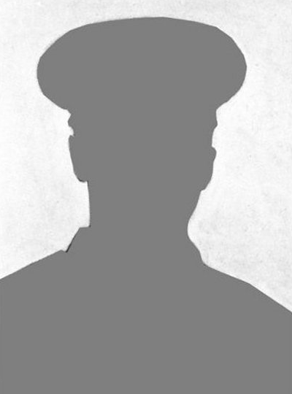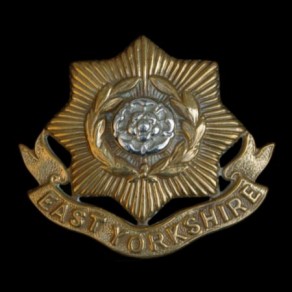‘Clitheroe Times’ (23 April 1915)
(Kindly supplied by Shirley Penman of Clitheroe and Dorothy Falshaw of Gisburn)
SLAIDBURN
MILITARY WEDDING
Great interest was taken on Monday morning in a marriage celebrated at the Parish Church by the Rector, the Rev. J.C. Garnett. The bridegroom was Company-Sergeant-Major William Arthur H. Smith, of the Irish Regiment, who leaves for active service in a few days, and the bride was Miss Emily Marjory Wilson, daughter of Mr. James Wilson, of South View, Slaidburn. The bride has been a member of the church choir for many years and is greatly respected in the village. Given away by her father, attended by her sister, Miss Bell Wilson, the bride was becomingly attired in a dark blue travelling dress and saxe blue hat. Mr. J.L. Wilson performed the duties of best man. After the ceremony a reception was held at the home of the bride.
‘Clitheroe Advertiser’ (14 June 1918)
(Kindly supplied by Shirley Penman of Clitheroe and Dorothy Falshaw of Gisburn)
[Untitled article]
Among a large number of missing officers and men is Lieut. W.A.H. Smith, son-in-law of Mr. and Mrs. Wilson, 13, Victoria Avenue, Chatburn, Mrs. Smith having been notified that her husband was reported missing on the 28th ulto. Twenty-seven years of age, he joined the Royal Irish Regt., when only 16, and was for some time stationed in West Africa. He was on furlough when war broke out in 1914, and immediately rejoined his regiment and went to France where he participated in severe fighting. It was on the Somme that he distinguished himself by a particularly brilliant piece of work which won for him the Military Cross and a commission. Badly gassed on one occasion, he had been wounded three times, and also suffered from malarial fever. When last in England, he was marked out for home defence, but, eight weeks ago, was reported fit, and returned to France. Sympathy is extended to the young wife in her great anxiety.
‘Clitheroe Advertiser’ (27 September 1918)
(Kindly supplied by Shirley Penman of Clitheroe and Dorothy Falshaw of Gisburn)
DEATHS
SMITH – Reported missing on May 27th, 1918 now officially reported to have died at Villers, Fraugneax [Villers-Franqueux], May27th – June 10th 1918, 2nd-Lieutenant W.A.H. Smith, M.C., of the 1st Batt. East Yorkshire Regt.; interred at Villers, Fraugneax, June 10th, 1918.
From his Widow, and Mr. and Mrs. Wilson and Family, 13, Victoria Avenue, Chatburn.
‘Clitheroe Advertiser’ (27 September 1918)
(Kindly supplied by Shirley Penman of Clitheroe and Dorothy Falshaw of Gisburn)
[Untitled article]
For over three months, Mrs. Smith, 13, Victoria Avenue, Chatburn, has been cherishing a hope that her husband, 2nd Lieut. W.A.H. Smith, M.C., (reported missing after the heavy fighting in May), was a prisoner in Germany. We are only too sorry that her hopes have been blighted by receipt of the information that ‘in an official list of dead received from Germany is 2nd Lieut. W.A.H. Smith, fallen, and buried on the 10th June, 1918, near Villers Fraugneax [Villers-Franqueux].’ 2nd Lieut. Smith had a very successful career. Joining the Army at the age of 16, he first became attached to an Irish regiment, and spent several years abroad. When war broke out in 1914, he was spending a furlough at Slaidburn, and immediately rejoined his regiment. He went straight to France, fought in the Mons retreat, and was eventually recommended for a commission. After qualifying, he was attached to the 1st East Yorks, and was awarded the Military Cross ‘for bravery and devotion to duty.’ Much sympathy goes out to the young widow in her bereavement.
‘Clitheroe Advertiser’ (13 December 1918)
(Kindly supplied by Shirley Penman of Clitheroe and Dorothy Falshaw of Gisburn)
[Untitled article]
Mrs. Smith, Victoria avenue, Chatburn, has received news relating to her husband, Lieut. Smith, who was killed on the 28th May last. Lance-Corporal H. Fletcher has written stating: “On the 28th May we were in the front of Hermonville when Lieut. Smith went out to reconnoitre a trench to see if it was occupied by the Germans. As he was going, a sniper hit him in the head, and he was killed instantly. I was in the trench and saw him killed. It would be about 11 o’clock in the morning. We had to retire, and I don’t think he would be buried, as the enemy took the ground. Lieut. Smith was in charge pending the arrival of Captain Green.”
THE EAST YORKSHIRE REGIMENT IN THE GREAT WAR 1914-1918 by Everard Wyrall (London: Harrison & Sons, Ltd. 1928)
THE BATTLE OF THE AISNE, 1918. 27th May-6th June.
It was strange how ill-luck dogged the footsteps of some divisions in France and Flanders. Two in particular – the 21st and 50th – were again and again almost wiped out, though their depleted ranks were as often filled and they re-entered the struggle as full of grit and courage as ever. Almost annihilated during the German offensives on the Somme, they had been transferred to the Lys, where they passed through a similar calamity; and for a third time, on the Aisne, they were about to suffer enormous losses. Thus, three times between 21st March and the end of June, the 1st and 1/4th East Yorkshires were practically re-formed. . .
As far as can be gathered, the dispositions of the 1st East Yorkshires on the night of 26th/27th May were as follows: ‘D’ Company held the line east of the Aisne-Marne Canal. ‘C’ and ‘A’ Companies (right and left respectively) held the Battle line, and ‘B’ Company was in reserve in a post in rear of Battalion H.Q., which were in a sumptuous dug-out in a trench adjoining Route 44. All Companies still held these positions when the storm broke in the early hours of the 27th.
About midnight, several gas shells fired by the enemy fell near Lieut.-Colonel Alexander’s H.Q. Thereafter, with slowly increasing intensity, the shell fire grew, until by 1 a.m. it was as bad as the holocaust which had swept the Somme on the 21st March. The front-line trenches and communications quickly became enveloped in clouds of noxious gas and smoke, telephone wires were cut, and the only means of communication were by runners, many of whom became casualties.
At 6 a.m. the sun was shining, but clouds of gas and smoke made visibility difficult. It was about this time that the first signs of a hostile infantry attack made themselves manifest to the 1st Battalion, by tell-tale attacks on the left flank. No news could be obtained of ‘D’ Company beyond the Canal, which, after putting up a desperate resistance against overwhelming numbers, was enveloped and captured almost en bloc. Two platoons of the left Company (‘A’) had also been taken, though only after hard fighting. For some time the enemy did not develop his frontal attack, but bent all his efforts on turning the flanks. The left front of ‘A’ Company commanded a valley running at right angles to the Battalion front, and down this depression the Germans advanced in great strength. The C.O. therefore sent up 2nd Lieutenant Middlebrook (East Yorkshire Regiment), of the 64th T.M.B., with his guns, lent to the Battalion for the Battle. The trench mortars put down a most effective barrage which successfully cooled of the enemy’s enthusiasm; for an hour or two he made no more attempts to advance up the valley. Then the T.M. ammunition gave out, but the officer commanding the Battery placed his men at the disposal of the East Yorkshires, and they worked as an independent platoon. At 11 a.m. the enemy made another drive down the valley, and two platoons from ‘B’ Company were sent up to reinforce ‘A,’ and two to ‘C’ Company.
The latter Company (‘C’) was in a desperate situation, time and again the enemy tried to separate them from the French troops on their right, but, acting in close co-operation, the East Yorkshires and the Moroccans beat off all attempts to drive a wedge between them.
Nevertheless, by midday, Germans on the left were between the left of the East Yorkshires and the K.O.Y.L.I., and were actually bombing the rear trenches of Battalion H.Q. ‘A’ Company, under great pressure, was now gradually falling back, whilst the wounded (walking cases) coming back from ‘C’ Company, reported that Company cut off. In reality ‘C’ was merely divided, part falling back and fighting with the Moroccans, and the other part retiring on Battalion H.Q.
Colonel Alexander, deciding that no sort of stand could be made at Battalion H.Q., ordered the remnants of his Battalion to fall back down the communication trench behind H.Q., and re-form in some existing trenches behind and in front of Hermonville village. A defence flank was to be formed facing west. These orders given, the C.O. sent the following message by runner to Brigade H.Q.: “Am forming defensive flank facing west and gradually withdrawing on Hermonville.” ‘B’ Company withdrew along Boyeau Luxembourg and formed the defensive flank facing west; ‘A’ followed to occupy Ouvrage Charpentier; ‘C’ fell back along Boyeau Dumont. Battalion H.Q. were established at the road junction south-east of Hermonville, the remnants of the Battalion being placed in defences east of the village and north and south of Battalion H.Q. The retirement had been made to the accompaniment of flank bombing from the left, whilst on the right the Moroccans were contesting every inch of ground. Those French Colonials fought well.
About 3 p.m. Colonel Alexander received a visit from the Brigade Major, and a little later was ordered to advance up the communication trench down which the remnants of the Battalion had retired, and retake the trench just west of Route 44, in which Battalion H.Q. had been situated. The advance began at 4 p.m. The head of the Battalion reached old Battalion H.Q. and found it full of German bodies, but almost immediately parties of the enemy appeared on both flanks, and, as one officer said, “Gave us a merry time.” In a few minutes the already depleted Battalion lost quite half of its small strength and only about 100 other ranks managed to get back to the line near Hermonville, where the remnants of ‘C’ Company, which had been with the Moroccans, came in from the Villers-Franqueux direction.
Along the Battalion front at least the Germans made no further advance that day, and at dusk a rapid reorganisation of the line was attempted. The Battalion strength was then about 100 other ranks.* …
*Officer casualties during the day were: 2nd Lieut. W.A.H. Smith killed; 2nd Lieuts. Varey and Woodhead wounded; 2nd Lieut. Boyes shell-shock and evacuated; 2nd Lieut. A.D. Robinson captured – a prisoner.
England & Wales, National Probate Calendar (Index of Wills and Administrations), 1858-1966
1919
SMITH William Arthur Heseltine of 13 Victoria-avenue Chatburn Lancashire died 27 May 1918 in France Administration London 31 January to Emily Margery Smith widow. Effects £59 10s. 6d.







No comments yet.